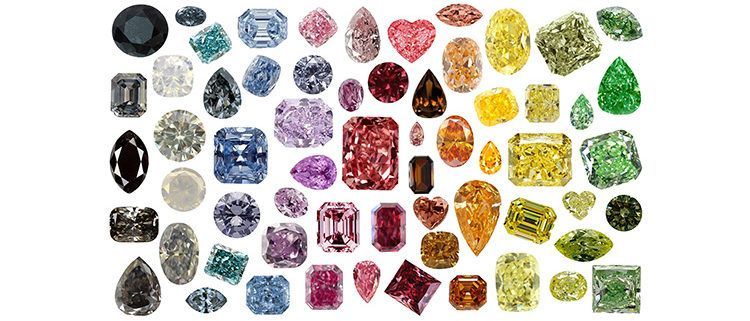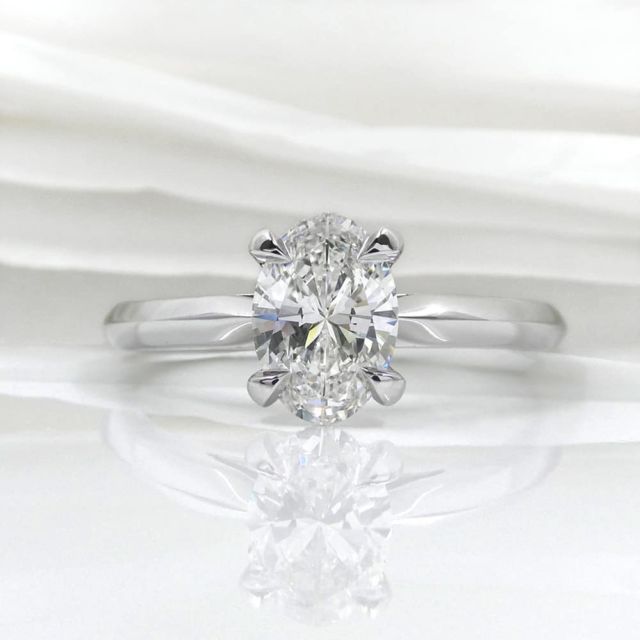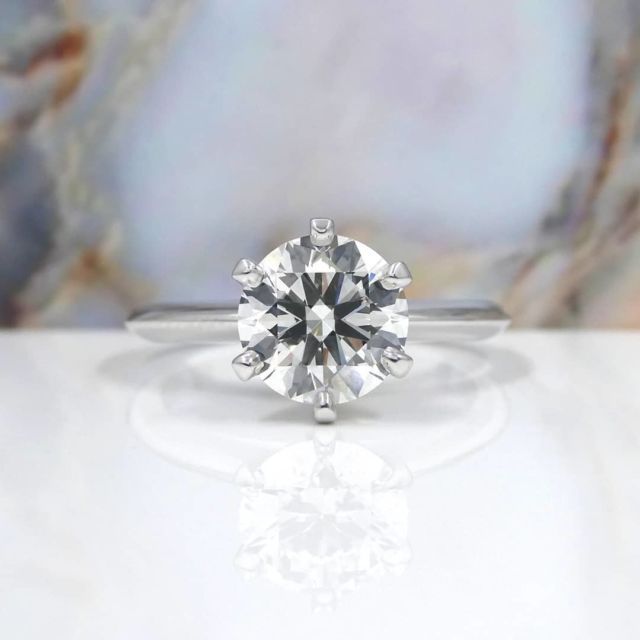Sara Cumming is the Jewelry Production and Social Media Coordinator at Kimberfire – a brilliant way to buy diamond engagement rings, fine diamond jewelry, and loose diamonds in Toronto, ON and across Canada. She holds a Bachelor of Fine Art from York University and a Diploma in Jewelry Arts from George Brown College. She is skilled in jewelry design using CAD software, as well as traditional goldsmith techniques. When she is not immersing herself in all things jewelry, Sara is a dog mom to Barley, her beagle mix rescue dog who loves a good tummy rub.
A Rainbow of Fancy Coloured Diamonds

We are all familiar with diamonds – that beautiful gemstone which is prized across the globe. Known for its sparkle and strength, and priced on its cut, carat, clarity and colour. Typical diamonds are valued based on their absence of colour, with the most valuable and rarest stones being completely colourless. However, there is another category of diamonds called fancy coloured diamonds and these diamonds can be worth much more than the colourless diamond. Coloured diamonds come in all different colours, and their price goes up the brighter and more intense the colour hue is. These fancy coloured diamonds are quite rare which is why they command such high prices.
How Diamonds Are Formed
Diamonds are composed of carbon and were formed at extremely high temperatures under extremely high pressure, deep within the earth’s mantle. Diamonds were brought close to the earth’s surface by deep volcanic eruptions millions of years ago. The volcanic material carried the diamonds within it and cooled into a hard material called Kimberlite, which is where we find most of the earth’s diamonds. Pure carbon creates a diamond that is completely colourless, but these stones are very rare, as little impurities, inclusions and other minerals get trapped with the carbon during a diamond’s creation. This is what causes some diamonds to be lower quality, as they are more yellowish and aren’t clear to the naked eye. But for fancy coloured diamonds it is the impurities and “defects” in the carbon structure which give the diamond its specific colour.
There is a colour scale for fancy coloured diamonds, which starts at pale shades and continues to very bright and saturated ones. The categories are Fancy Light, Fancy, Fancy Deep, Fancy Intense and Fancy Vivid. Fancy Vivid diamonds are the rarest.
All the Natural Colours of the Rainbow
Yellow
Yellow diamonds are the most commonly seen fancy coloured diamond. They are also one of the most common in nature, next to brown diamonds. They are less rare and correspondingly less expensive to purchase, but still cost as much and often more than a high quality white diamond. These diamonds are often referred to as canary diamonds. Yellow diamonds get their colour when nitrogen replaces some of the carbon atoms in the structure. The more nitrogen “impurities” in a stone, the more yellow the diamond appears.
Blue
Blue diamonds are very rare and because of this they are extremely expensive. Usually they will be a grey-blue colour and rarely will they be a strong blue colour like a sapphire. Only one out of 200,000 diamonds will have a hint of blue and it is usually very pale. The most famous blue diamond is the Hope Diamond, which weighs an impressive 45.52 carats. Blue diamonds get their colour from boron that has been trapped in the crystal structure as it was forming.
Pink and Red
Red is the absolute rarest of diamond colours and only a small number have been discovered. Because of their rarity they command huge prices and are mainly bought by gem collectors or investors. Pink diamonds are also very rare and are extremely coveted. A pink diamond is considered the ultimate luxury item. 90% of the world’s pink and red diamonds come from the Argyle Diamond Mine in Northwest Australia. Unlike other coloured diamonds, no mineral impurity has been found to create the pink or red colour. It is thought that during the diamond’s voyage to the earth’s surface it undergoes changes in its electron structure, called plastic deformation. This deformation traps electrons so that they interact with light to produce a pink or red colour.
Green
Natural green diamonds are extremely rare and are usually a light and muted hue. Green diamonds get their colour as they are exiting the earth’s last layer of crust. It is at this time that they absorb naturally occurring radiation in the soil. The radiation usually only colours the diamond’s outer surface – they are not usually green all the way through the stone. Even advanced gemologists have trouble determining if a green diamond was coloured naturally or enhanced by man. Because of this, green diamonds are always regarded with suspicion and heavily examined in labs before they are given a grading.
Orange
Orange diamonds are not as rare as some of the previous colours, but still aren’t too common. These diamonds are coloured by nitrogen, just like yellow diamonds. But the nitrogen atoms in the orange diamond are assembled in a very specific way. To produce the orange colour, the particles absorb blue light and some yellow light.
Purple
Purple diamonds usually have tints of purple and a secondary shade, such as pink, red, blue, grey or brown. It is very rare to find a pure purple coloured diamond. It is believed purple diamonds get their colour from a combination of crystal distortion (such as the pink diamond has from deformation) and a high presence of hydrogen as the stone is forming.
Grey
Grey diamonds are a good option for those who are looking for a lower priced coloured diamond. While they are still very rare, they are not priced as high as the other colours. They get their grey colour from high levels of hydrogen. The one big plus for the grey diamond is that it is easily found in the round brilliant cut. The round brilliant cut is definitely the most popular diamond cut and yet most coloured diamonds are usually cut into radiant or cushion cuts. That’s because the brilliant cut was created to produce the most reflection of light, and thus make the stone appear whiter. Gem cutters don’t want fancy coloured diamonds to appear whiter so they will usually cut coloured diamonds in shapes that will help the stone retain the most colour.
Brown
Brown diamonds are the most commonly found fancy coloured diamond and are the most affordable. Brown diamonds were likely the very first diamonds to be used in jewellery. These diamonds are found in numerous shades, like the pale browns which are usually referred to as Champagne Diamonds, to the deep browns which can be referred to as Cognac or Chocolate Diamonds. These diamonds get their colour from plastic deformation.
Black
Black diamonds are fairly new to the jewellery world as designers only started using them in the 1990s. Before that these diamonds were mainly used for industrial purposes. Natural true black diamonds are very rare and the ones seen in jewellery are usually treated to become blacker. Black diamonds get their colour (or lack thereof) by a large amount of dark inclusions spread throughout the stone. Black diamonds do not reflect light, but rather absorb light and have an opaque, glossy surface. They are older than any other diamonds on earth and some scientists believe that they came from meteorites. Black diamonds are so hard that they can only be cut by other black diamonds.
White
Typically when people hear white diamond they think of the traditional colourless diamond, but there is actually a Fancy White diamond, which is actually white. These diamonds have tiny microscopic inclusions, thought to be nitrogen, that diffract light off of the stone. This light diffraction gives the fancy white diamond a milky, opalescent appearance.
Colour-Treated Diamonds
All the colours above have been in reference to natural diamonds, ones that were created in the earth without human influence. However, a lot of the coloured diamonds that are found in jewellery are colour-treated, meaning that undesirable coloured diamonds have been treated to enhance their colour. This process can take a light brown coloured stone and turn it into a purple diamond, or change a yellowish stone into a colourless one. There are a few different treatments that make this happen. The most common is High Pressure High Temperature (HPHT) where the stone is put under those conditions to change the colour. There is also a procedure called Irradiation, where the diamonds are exposed to high energy electron or neutron particles which move carbon atoms out of place and physically alter the crystal lattice. Another treatment is that of surface coating where a thin layer of coloured material is deposited on the diamond, and this treatment is not permanent. Lastly there are synthetic coloured diamonds which are lab grown diamonds that are created under the types of conditions that natural coloured diamonds would be exposed to. All these different treatments significantly decrease the value of the coloured diamond, which is why you only want to buy a coloured diamond from a seller who will provide a grading report from a trusted lab such as GIA.
A Rare Beauty
Coloured diamonds are so coveted and so special because they are so rare. For any given colour to be created there were thousands of variables that had to be present at the exact right time. All those factors coming together to create lemony yellows, cool blues and pretty pinks is really science at its most beautiful. While not everyone may be able to afford a coloured diamond of their own, I think we can all appreciate such a beautiful natural creation.
About Kimberfire
A brilliant way to buy high-quality engagement rings, diamonds, and jewelry. View and inspect your carefully selected diamond virtually (via Zoom), or in our offices in Toronto, Canada. We ship worldwide.
Leave a Reply
Want to join the discussion?
Feel free to contribute!







